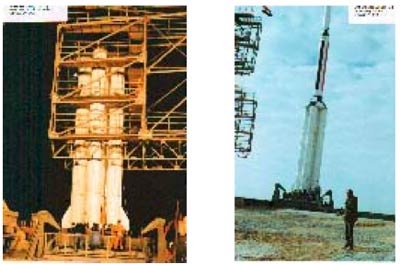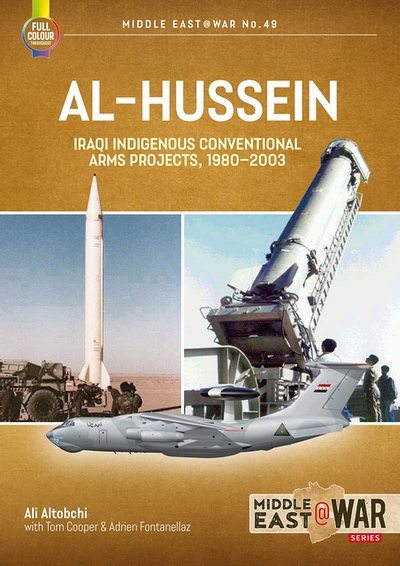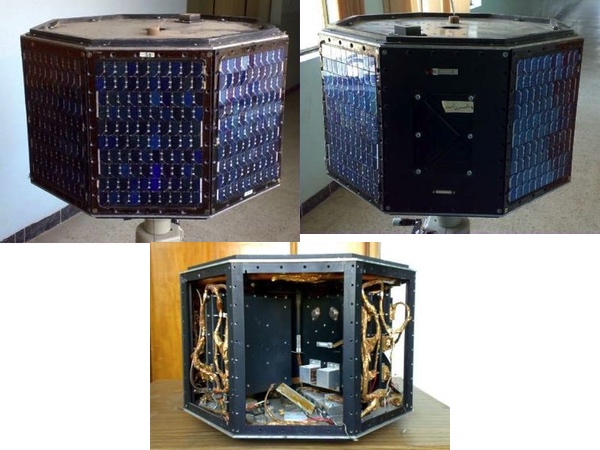From the sand to the stars: Saddam Hussein’s failed space programby Dwayne A. Day
|
| Although more than three decades have passed since the end of the Iraqi space program, and Saddam has been dead since 2006, there is still relatively little information available on the Iraqi space program. |
On December 5, 1989, Iraq launched a 25-meter-long rocket from a launch pad 230 kilometers southwest of Baghdad. Iraq described this as a “satellite launch system.” This was only a test of the first stage, and the vehicle’s second and third stages were mockups. The CIA determined that this was not a prototype ballistic missile: it was large and ungainly, and had to be launched from a fixed position making it vulnerable to attack. In a declassified top secret 1990 report, Iraqi Ballistic Missile Developments, the CIA stated that Iraq was indeed trying to build a satellite launching vehicle, but faced many technical challenges, such as staging and guidance.
After the United States invaded and occupied Iraq in 2003, it was possible for US intelligence agencies, as well as the United Nations, to roam Iraq collecting evidence about its various weapons programs. The United Nations Monitoring, Verification and Inspection Commission, known as UNMOVIC, gathered substantial information on various Iraqi ballistic missile programs, including information on the Al Abid space launch vehicle. Much of the information was gathered from documents turned over by the Iraqis in 1995 after a high-level defector prompted the Iraqis to preemptively release documents they had been hiding. The material had been buried at a chicken farm in Iraq. The defector later had second thoughts, returned to Iraq, and was promptly assassinated by the regime. UNMOVIC also gathered additional information after the American invasion in the form of interviews and other documents. That information is contained in a report on various Iraqi weapons of mass destruction. In addition, some information emerged from Iraqi officials involved in their satellite program.
Starting a space program
According to Sarmad D.S. Dawood of the Space Applications Center of the Space Technology Directorate of Iraq’s Ministry of Science & Technology in Baghdad, Iraq’s Scientific Research Council established a research center to develop space technology from 1988 until 1990. The research center started the Al-Ta’ir project, which means “The Bird” in Arabic (although the name, which is also applied to a star in the constellation Aquila, also translates as “flying eagle.”) Al-Ta’ir was a small experimental satellite for conducting communications and ranging experiments. It would have operated in the VHF and UHF amateur frequency ranges.
During a 2010 small satellite conference, Dawood stated in a presentation that the research center built two identical flight-ready satellites. The satellites still existed at that time and were in storage at the Ministry of Science & Technology in Baghdad. The project also included a tracking, control, and communications station.
The research center’s plan was to launch one of the satellites aboard an Ariane 4 rocket, and the spacecraft designers used an Ariane 44L vehicle as their baseline. Their plan was to launch the satellite into an orbit of 350–400 kilometers, presumably as a secondary payload. The Ariane 4 only flew to polar low Earth orbit or to geostationary transfer orbit, but a polar orbit would have limited Iraq’s ability to regularly communicate with its satellite.
The satellite was an octagon with a height of 47 centimeters, a diameter of 74 centimeters, and a mass of 75 kilograms. The interior of the satellite was divided into four bays for holding electronic boxes and withstanding the shock and vibration of launch. The satellite was solar powered, with seven solar panels and backup batteries.
| Apparently after being rebuffed by the French government or Arianespace over the use of the Ariane 4 to launch their satellite, Iraq began development of its own rocket to launch the Al-Ta’ir satellite. |
The satellite subsystems included an onboard data handling system, a radio frequency communication system composed of VHF and UHF amateur band units that communicated voice and telemetry and telecommand data, and an attitude control system. Thermal control was passive, using light and dark paint.
The satellite was spin stabilized. Attitude control would have been accomplished with a technique first developed by the United States military in the early 1960s consisting of two electrical coils mounted on the top and bottom sides of the spacecraft. When an electrical current was passed through them, these coils would interact with the Earth’s magnetic field, keeping the satellite properly oriented.
 In December 1989, Iraq launched its Al Abid space launch vehicle. Only the first stage, which consisted of a cluster of five Scud ballistic missiles, was active. Although the vehicle exploded after 45 seconds, it was considered a successful test of the clustered first stage concept. (credit: UNMOVIC) |
Al Abid
Apparently after being rebuffed by the French government or Arianespace over the use of the Ariane 4 to launch their satellite, Iraq began development of its own rocket to launch the Al-Ta’ir satellite. According to UNMOVIC, the rocket reportedly had several names, including Comet and Al-Ta’ir, but it seems likely that the UN agency confused the rocket and satellite programs and that the rocket was always called the Al Abid and the satellite was Al-Ta’ir.
The project was carried out under the overall direction of the Ministry of Industry and Military Industrialization. In mid-1988, the Iraqi government asked Canadian “Supergun” expert Gerald Bull’s Space Research Corporation to study development of a launch vehicle capable of placing a 100- to 300-kilogram payload into a 200- to 500-kilometer orbit, although UNMOVIC reported that the planned initial payload was only 50 kilograms. Space Research Corporation engineers chose to develop a clustered rocket design. The third stage diameter was 1.25 meters, more than sufficient to carry the 0.74-meter diameter Al-Ta’ir satellite. According to Iraqi officials involved in the program and interviewed later, the project was always civilian.
At the time, Iraq had many Scud missiles to provide a technology source. The Scud was a short-range ballistic missile exported by the Soviet Union in large numbers. Iraq had conducted modifications on the missiles to increase their range. Space Research Corporation evaluated several different options, including configurations of four to six extended-burn-time Scud rockets clustered around a single extended-burn-time Scud as a second stage and a new third stage. By early 1989, the Space Research Corporation had settled on a design consisting of five Scuds clustered for the first stage, another for the second stage, and a “double-base propellant” rocket for the third stage.
A second team, apparently consisting of two foreign experts from an unnamed country, also assisted the Iraqis. The foreign specialists proposed a different design: a single Scud as a core stage surrounded by strap-on rockets consisting of four or eight SA-2 liquid propellant rockets from a surface-to-air missile, or four or eight Scud rockets. The second stage would be either liquid or solid propellant, and the rocket would also include an apogee kick motor. Space Research Corporation experts rejected this design approach.
The Iraqi program’s leadership produced a development schedule for the Al Abid with the goal of making the first launch by December 12, 1990. Initially, the design had an enlarged payload shroud to house the satellite, giving it a hammerhead appearance. But General Ra’ad, who oversaw Iraq’s missile development programs (no other details about him are included in the UNMOVIC report), proposed increasing the diameter of the third stage to 1.25 meters, the same as the second, to avoid this hammerhead shape. He also designed a clamshell payload fairing. It is not clear how much the Space Research Corporation engineers were involved in the actual development of the rocket beyond the initial designs. At least one senior Iraqi informed the UN inspectors that Space Research Corporation was not involved, but others have said that the company provided technical assistance when necessary.
By mid-1989, the Al Abid design consisted of a five-Scud first stage, a 1.25-meter diameter liquid-propellant rocket for the second stage, and a third stage that might have been a modified Scud with a larger diameter tank. The Scud is 0.88 meters in diameter, so the second stage was actually wider than the individual Scuds used in the first stage.
Testing and foreign assistance
In December 1989, the Iraqis conducted their first test launch of the Al Abid from a fixed launch site at Al Anbar. Although this was only a test of the first stage, it took place a mere six months after development of the project timeline—a fast pace that UNMOVIC attributed to foreign assistance as well as the “practical approach in modifying and developing different versions of the Scud” that project manager General Ra’ad had pursued. The second and third stages were steel mockups. A videotape retrieved from the Haider chicken farm in 1995 showed that the first stage, with its cluster of five Scuds, worked successfully for 45 seconds until the vehicle exploded. The Iraqis suspected that explosive bolts between the first and dummy second stages may have fired prematurely, causing the accident, but this was still a partial success at getting a complex vehicle off the ground. Many rockets barely leave the pad during their first launch, but the Al Abid had demonstrated that it could get off the ground despite the challenges. (An alternative explanation, which appeared in a 2004 CIA report, stated: “At about Mach 1, the aerodynamic stresses overcame the control authority and the missile inter-stage collapsed, according to an interview with a senior missile official…”)
| There is still much confusion about the Al Abid because of its connections to the Iraqi effort to develop a long-range missile for delivering an atomic weapon. |
The Iraqis realized that the performance of the second stage was crucial to the overall performance of their rocket. The Scud liquid propellant engine lacked the necessary thrust. They initially sought to increase the performance by increasing the expansion ratio of the engine nozzle and changing the fuel. The Scud nozzle was designed to operate from sea level up, so it was relatively narrow. The second stage would ignite at higher altitude, and if it had a wider expansion nozzle it would improve the thrust performance. The designers changed the expansion ratio from 10 to 30 by adding a skirt. They also changed the TM 185 fuel to diethylenetriamine (DETA) or a mixture of DETA and unsymmetrical dimethyl hydrazine (UDMH). An initial engine test was partially successful until the expansion skirt burned through—a result of being tested at sea level rather than at simulated high altitude.
The Al Abid third stage remains somewhat mysterious, and it is unlikely that work progressed very far on it before the project was canceled. Although UNMOVIC released several crude Iraqi drawings of the rocket at various development stages, they reveal few details of the third stage. One document indicated a single rocket nozzle that seems relatively small given the upper atmosphere requirements for a large expansion rocket nozzle.
The Iraqis also approached two foreign countries to purchase a more powerful engine, but were rebuffed. The countries offered to launch Iraq’s satellites themselves, but would not sell them engines. The Iraqis also apparently began developing a new first-stage engine with four Scud combustion chambers and a single turbopump. However, development work halted with the onset of the 1991 Gulf War.
After the December 1989 test launch, the Iraqis decided that the second and third stages of the Al Abid should be tested separately. They planned a test for autumn 1990 that they referred to as Al Kharief, or “Autumn.” The Al Kharief plan became the focus of international controversy. United Nations inspectors claimed that this was a new missile, whereas the Iraqis claimed that it was simply the upper stages of the Al Abid space launch vehicle.
Around mid-1990, Al Kharief work was proceeding very slowly, prompting a meeting of all relevant parties. Project leaders realized that the development was plagued by disagreements and differing priorities. The Al Kharief test progress slowed to a halt, and the August 1990 Iraqi invasion of Kuwait led to the suspension of all activities. According to General Ra’ad, no final report was ever produced and no drawings of the vehicle were available.
Dual-use rocketry
There is still much confusion about the Al Abid because of its connections to the Iraqi effort to develop a long-range missile for delivering an atomic weapon. At the time that the Iraqis were developing their satellite launching vehicle, Western intelligence agencies strongly suspected that Iraq was actively interested in developing atomic weapons and delivery systems for them. In 1987 Iraq had secretly restarted its atomic weapons program, which had been stagnant ever since an Israeli airstrike took out their nuclear reactor at Osirak—an airstrike that included a young pilot named Ilan Ramon, who would later be killed during the shuttle Columbia accident.
The atomic weapon the Iraqis were trying to build would weigh more than two metric tons with a diameter of 1.25 meters. The missile required a range of 650 kilometers. These requirements were beyond the capabilities of Iraq’s missiles, so the nuclear weapon designers were told that they would have to reduce the size of their planned weapon.
| Iraqi work on space launch vehicles did not come to a complete stop after Operation Desert Storm in 1991. |
In April 1989, Iraq started work on Project S-13, the development of a long-range nuclear-tipped missile. Initially, Project S-13 evaluated three options: a 1.25-meter diameter missile capable of delivering a one-ton weapon 1,200 kilometers, a derivative of the Al Hussein/Al Abbas missile that could reach 650 kilometers, and an unmodified Scud-B missile with a range of only 300 kilometers. A senior Iraqi military leader later stated in an interview that although the weapons designers declared in 1988 that they wanted a missile ready by 1991, he believed it would take until at least 1993 to produce one.
Whereas the available documents indicate that the Iraqis evaluated three possible missiles as part of their S-13 work, there is some indication that the satellite launch vehicle project—particularly the Al Kharief second and third stage test—was also linked to weapons development. The UNMOVIC report stated that General Amer Al Sa’adi, who was in charge of Iraqi strategic weapons development, claimed that his plan was for the Al Abid space launch vehicle’s second and third stages to form the basis of a missile for delivering an atomic weapon. But General Ra’ad, who was in charge of the Al Abid development, insisted that he was unaware of plans to use his rocket for nuclear delivery and that nobody ever approached him about using the Al Kharief for such a purpose. General Ra’ad may have been unaware of or disagreed with the weapon plans, but UNMOVIC investigators concluded that there was a link between the programs, “although the precise details of the relationships are unclear,” the investigators wrote. UNMOVIC added, “What is clear, however, is that these activities were contributing to the long-term solution for a delivery vehicle for the nuclear weapon under the overall control or oversight of General Amer Al Sa’adi.”
 A new book has information on many Iraqi weapons programs, including its ballistic missiles. |
Grounded birds
According to a CIA report produced after the 2003 invasion of Iraq, Iraqi work on space launch vehicles did not come to a complete stop after Operation Desert Storm in 1991. In a section of the report called “Multistage Launch Vehicle Simulations (1990-95),” the CIA stated that in 1991–92, Iraq conducted flight simulations of a three-stage missile incorporating Scud-type missiles. The CIA stated that the United Nations had information from an Iraqi official that this was a theoretical study that included trajectory calculations for several clustered SA-2 surface-to-air missile engine configurations. The configuration was different from that of earlier work conducted on Al Abid.
In 1993, Iraqi engineers were ordered to design a turbopump capable of simultaneously feeding a cluster of four SA-2 engines. But no turbopumps or engine clusters were produced. At the end of 1994 through early 1995, Iraq performed studies for multi-stage launch vehicles using performance parameters derived from clustered SA-2 engines. But these paper studies apparently ceased in 1995, and the country abandoned plans for its own space launcher and space program.
Recently, Ali Altobchi, along with Tom Cooper and Adrien Fontanellez, published a new book on Iraqi conventional weapons efforts. Titled Al-Hussein – Iraqi Indigenous Conventional Arms Projects, 1980-2003, the book is heavily illustrated and covers many different projects, from ballistic missiles to aircraft and artillery weapons. Unfortunately, the book only has a short entry on the Al Abid (referred to as “Al-Aabed” by the authors). The authors state that nosecone heating was too big a problem for the designers to overcome, although a space launch vehicle would have experienced less heating during ascent than a ballistic missile nosecone, so the statement is confusing.
If any Iraqis involved in the launch vehicle program have told their stories, we have yet to learn about them three decades later. The full history of the Iraqi space program has still not been written.
Note: we are using a new commenting system, which may require you to create a new account.
